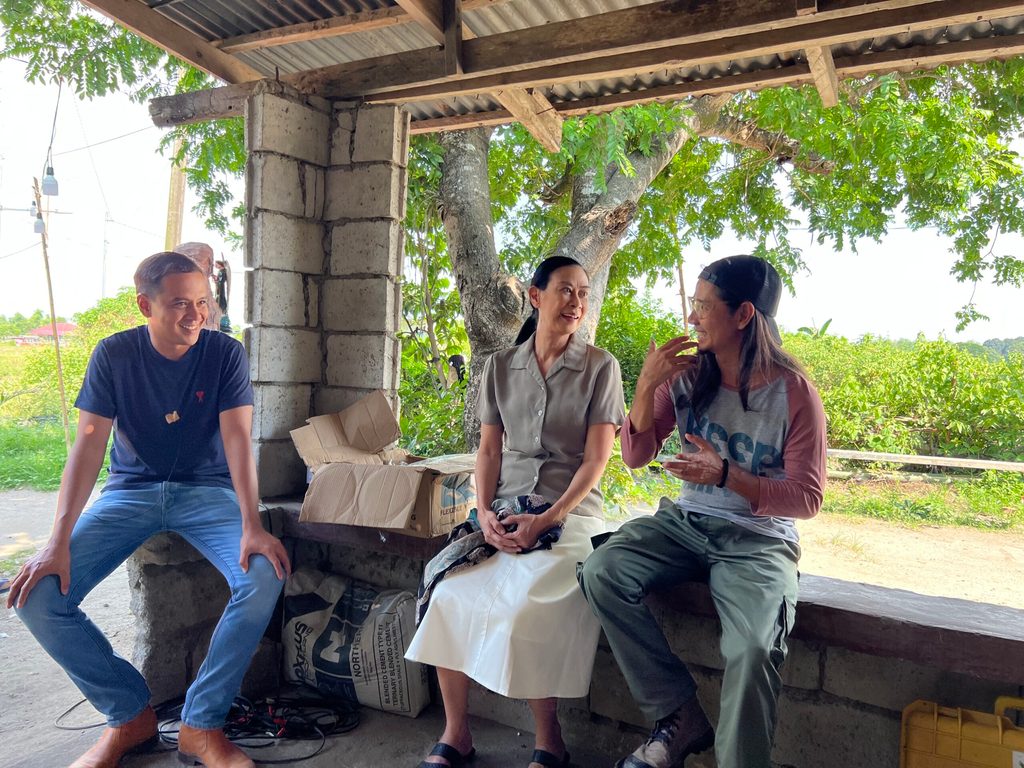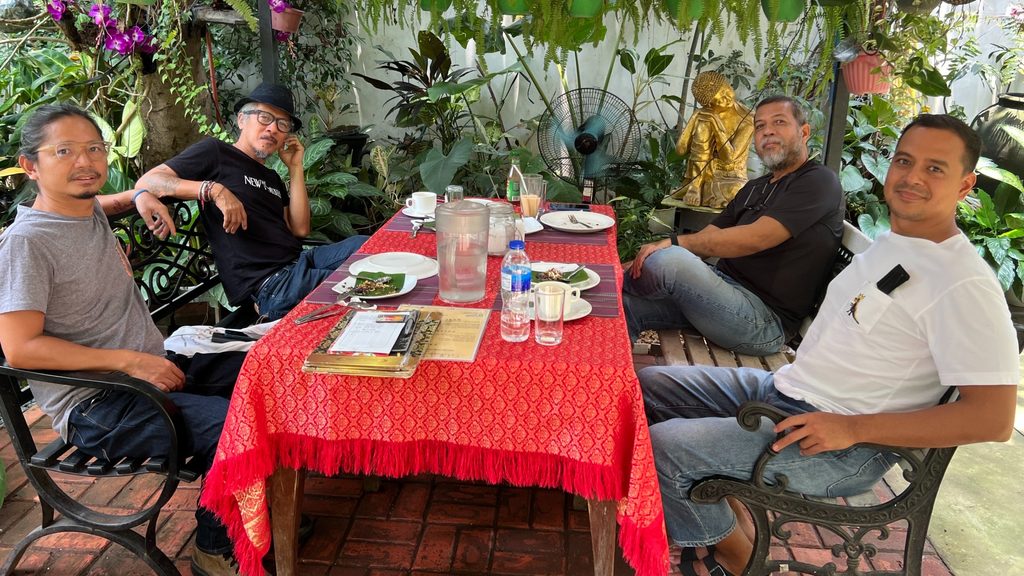MANILA, Philippines – Sometime in 2016, director Bor Ocampo was given a script by fellow Kapampangan filmmaker Jason Paul Laxamana.
The story was set in Porac, the largest town in Pampanga, where the latter shot his debut short, Anak Ning Kapri, 10 years ago. In Porac, Ocampo became acquainted with Laxamana.
Titled Moneyslapper, that script reached the hands of John Lloyd Cruz around March 2017, sent in by the auteur Lav Diaz.
Cruz at the time had already completed two features with Diaz, whom Ocampo had yet to meet.
It was the first script Cruz had pored over after leaving ABS-CBN, his network of two decades. “Hindi ko na siya nabitawan. Parang tingin ko noon, kung hindi namin ‘to magagawa, parang habangbuhay ko siyang iisipin,” said the actor.
(I could no longer turn it down. I thought at the time, if we could not make it happen, I’d carry it for the rest of my life.)
A month after reading the material, Cruz reached out to Mikee dela Cruz, the line producer and Ocampo collaborator who had initially asked Lav Diaz to to send the script to the actor.
At a meeting at Cruz’s house, the actor told his future director Ocampo that he takes his projects ploddingly. “I think that pacing reflected in the film,” said Ocampo in a mix of English and Filipino.
Little did both know that the remark would morph into a gestation period of Moneyslapper, which is now set to have its world premiere — seven years since the wheels started turning — in the Asian Next Wave section at this year’s QCinema International Film Festival.
At the center of the dark thriller is a young man abandoning his hometown after a historic lottery win and returning half a decade later to confront what he has become and how wealth has eroded him.
Ahead of the film’s gala, I met Ocampo on a Tuesday afternoon at The Patio in UP Diliman’s University Hotel. Driving straight from Pampanga, he came in a casual getup: a black shirt and a pair of jeans, long hair tied in a loose pony, eyewear hanging around the neck. Before Cruz arrived about an hour into the interview, the director had begun sharing stories, at times waxing poetic but mostly putting things into context.
Ocampo spoke about the push-and-pull nature of the project, some of it he’d rather keep off the record. A second meeting with his lead actor in March 2018 would take place. Cruz insisted on it. He apologized to Ocampo for the setback the film had to endure — although, at the time, it was all just spit and a handshake, no contracts yet.
“[He said] the film dragged on because of him. On my part, there was no contract — so that [time spent during the earliest parts of the project] was not counted. But I appreciated that that’s how his treatment was,” recalled Ocampo.
Prior to the completion of Moneyslapper, Ocampo already had two features under his belt, Dayang Asu, for which he won best director at Cinema One Originals in 2015, and Hitboy, his 2018 CineFilipino entry, as well as a number of shorts like EJK and Digpa’ Ning Alti.
The director reckoned that circumstances would finally favor them towards the project’s fruition after the 2018 meeting. After that, he assembled a new crew — only to contend with the demise of his father in November that year.
Such is the reason why he is inclined to dedicate the film to his father, who was a religious lotto bettor and even named him after the dictator Marcos, a paradox of sorts, as he put it to me.

That backstory could in part explain the intention of the film. “It’s not necessarily to transform the world, but to actually let us think. To give us an opportunity to question things, our traditions. Maybe there’s something wrong already,” argued Ocampo.
Another hurdle surfaced in early 2019. Cruz was about to raise a son at the time, so he pulled out of the film and asked Ocampo to cast another lead. The director then held an audition at UP Cine Adarna, but the effort went for naught.
A few months before the pandemic, Cruz picked up the project again and met up with Ocampo at UP Vargas Museum. It was a juncture of gauging each other.
Instead of talking about the material, they discussed issues with mainstream filmmaking, novel approaches to be integrated during filming, and proper working conditions. They even shot a short film called Magiliw around that year to test their rapport.
Then came the decision to hire another writer in February 2020. Through the urging of writer-editor Erwin Romulo, Cruz’s close pal, Norman Wilwayco, author of titles like Mondomanila and Gerilya, got on board.
“It felt like we needed a new set of eyes,” said Cruz, who aptly arrived in a white QCinema shirt and denim pants, a bucket hat, and tote bag. A pair of black, full-rim glasses hung around his neck. He was wearing a blue mask.
He seemed relaxed with interviews, although he rarely does it these days, and would even raise questions of his own at times. The humor he was not reluctant to show would only accentuate his sunny, unassuming presence.
When I pressed him about the creative fluctuations the material had to weather, Cruz said all of that would find a common thread in their learnings while making the film. “What this script went through, we also went through,” he explained.
The initial progress of the film, after securing Wilwayco’s commitment, was short-lived due to routine lockdowns. Then leading a new life in Katipunan, Ocampo went back to Pampanga and pursued farming. When the pandemic subsided, Cruz got in touch with him. They did preproduction online.
Cruz was responsible for the stacked cast, whom they had sit-downs with via Zoom. So began the entry of seasoned theater and screen actors, such as Jasmine Curtis-Smith, Charlie Dizon, Lav Diaz, Susan Africa, Ronnie Lazaro, Mercedes Cabral, Joel Saracho, Mae Paner, and Rox Lee — most of which, including the crew, Cruz had already worked with in Diaz’s films.

They began principal photography in May 2022 in a lock-in setup. Ocampo noted how hands-on Cruz was throughout filming, albeit the director’s initial discomfort because he was used to doing his own thing.
There was even a detail in the edit, a scene towards the film’s coda, that Cruz fine-tuned, and Ocampo sensed that would happen. The director said he shoots with the edit in mind, or at least 80% of it; the rest is a leeway for possibilities. “Tawirin na lang natin ‘pag nandiyan na (We’ll cross the bridge when we get there).”
Ocampo also brought up the effort in selecting each location prior to actual production, which allowed him to imagine and rethink every scene in his lead, to the extent that it appeared in his dreams. But he was quick to dispel monopoly on the entire process.
(Speaking of the edit, Ocampo only learned about the R-18 rating handed by QCinema to the film at the festival’s press conference last October. It caught him off guard and said he could have calibrated the edit had QCinema informed him beforehand.
He was fretting over the likelihood that the Movie and Television Review and Classification Board might use it as a basis, which could mean no huge theatrical run, since SM Cinema only screens films with G to R-16 rating.)

Be that as it may, Cruz is most excited about what lies ahead of Ocampo. “How it will flow through Bor, how it will affect him, and what his takeaway will be from this opportunity for Moneyslapper, from his exposure to QCinema.”
When Cruz said yes to Moneyslapper, it was no longer about the script given to him or the exposure to so-called off-beat, anti-hero characters, which were not new to him, even questioning notions of a “hero” in the Philippine milieu. It was more about grasping a better understanding of his practice, especially in such a fraught period in his career.
“Ba’t ko ba pinipili, ba’t ko ba ginagawa ‘yung ginagawa ko,” he mused. (Why do I choose this, why do I do what I do?)
He said of Daniel, the lead character he takes on, “He’s like living in the fiber of what is happening to a person, especially to a Filipino. It’s molecular like that. I was attracted to the opportunity and vulnerability of this character because, in a way, this is the kind of story that if it happens to you, you’re better off not sharing it. You’ll move past it.”
“It’s his story, but he’s not in control of it,” he continued. “Is this really a character? I don’t think so. I think this is the learning of the character.”
It’s not far-fetched to say that the film, given its seven-year incubation stretching across two violent regimes and a global health threat, is gargantuan and ambitious, suffused with things to mull over, in cinema and in real life.
And like Daniel, Cruz is still in the process of learning.
It seems like he invites us to learn alongside him. – Rappler.com
Note: Some quotes in Filipino have been translated into English for brevity.


